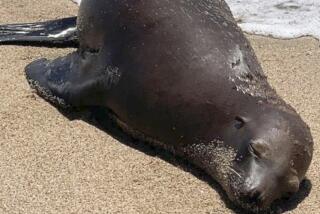As Go the Sea Lions, So Go the Fishermen
- Share via
The world’s largest species of sea lion is starving to death. Unless steps are taken to reverse the plummeting population of Steller sea lions, magnificent animals that inhabit the northern Pacific and grow to the size of a Volkswagen Beetle, many scientists believe that the species is doomed. However, the long-term effects are not limited to this species.
Steller sea lions eat a variety of things, including Pacific cod, salmon, octopus and pollock, which is a mainstay of their diet. But industrial fishing in the northern Pacific has shriveled their food supply, and their numbers have been failing steadily for three decades. As recently as 1960, more than 175,000 sea lions made their homes on the rocky, wind-swept islands off the Aleutian Peninsula and in the Bering Sea. Today only about 25,000 are left, turning once noisy rookeries into ghost towns.
The sea lions’ decline coincided with a virtual explosion of commercial fishing in the North Pacific, first by foreign factory trawlers in the 1960s and ‘70s, and then by American vessels. In the mid-’70s, an estimated 440 million pounds of pollock per year were hauled from these waters. By 1998, the annual pollock catch topped 2 billion pounds, much of which winds up as frozen fish sticks and fish sandwiches at U.S. fast food chains. In 1997, after years of legal battles by environmentalists, the Steller sea lion was finally listed as an endangered species and accorded the protection of the Endangered Species Act.
Pressured by politicians and the fishing industry, federal regulators were reluctant to restrict the pollock catch in the sea lions’ feeding areas, a necessary step toward restoring the sea lion population. But on July 21, U.S. District Judge Thomas Zilly of Seattle, petitioned by several environmental groups, ruled that the National Marine Fisheries Service has failed to protect critical sea lion habitat, thus violating the Endangered Species Act. The judge issued an injunction prohibiting one specific type of fishing--groundfish trawling--within 20 nautical miles of sea lion rookeries and breeding areas.
Despite the ensuing cries of protest from commercial fishermen and some Alaska politicians who recently initiated efforts to try to get a federal appeals court to overturn the injunction, Judge Zilly made the right decision--for the sea lion, for the marine environment and ironically for the thousands of men and women who depend on that environment for their livelihood.
For it is not only the sea lion whose future is on the line, but the broader ecosystem in which it lives. Other species in the northern Pacific that rely on pollock are also in trouble. Among them are northern fur seals, Pacific harbor seals, spotted and ringed seals, and several bird species, including kittiwakes, murres and puffins. Deprived of sea lions and seals to eat, killer whales have begun preying on sea otters, a phenomenon that was virtually unknown in the past. Now, in the central Aleutians, sea otters are becoming scarce.
Nor are humans exempt from this crisis. In the long run, the path of the sea lion is likely to be the path of the fishermen. Unless steps are taken to restore the Steller sea lion and numerous other species that are suffering from excessive fishing, thousands of jobs and hundreds of millions of dollars may eventually be lost. This is precisely what occurred in 1994 with the collapse of the New England fishery and the closing of Georges Bank, once among the richest fishing grounds on Earth.
At the root of Judge Zilly’s decision is the premise that the fate of keystone species like the Steller sea lion is intrinsically tied to our own. That is what the Endangered Species Act is really all about: us and them. If we allow this animal to go the way of the passenger pigeon and the dodo, we are likely to lose more than just a species of sea lion. The bottom line is we are taking too many fish from the North Pacific in the wrong places and at the wrong times. The sea lion is suffering today. Tomorrow it will be the men and women who depend on fishing for a living.
Unless we do a better job at managing our North Pacific fisheries in ways that enable sea lions to coexist with fishermen, we will eventually face a situation where there will be no sea lions, no fish and no fishermen to catch them.
More to Read
Sign up for Essential California
The most important California stories and recommendations in your inbox every morning.
You may occasionally receive promotional content from the Los Angeles Times.










